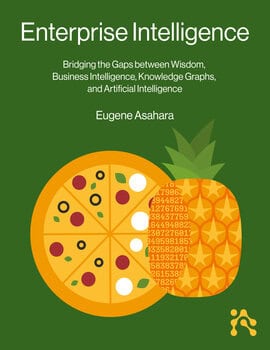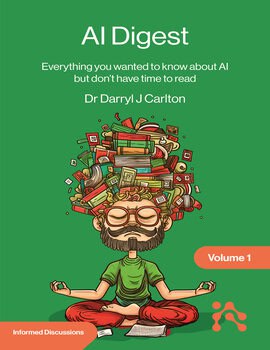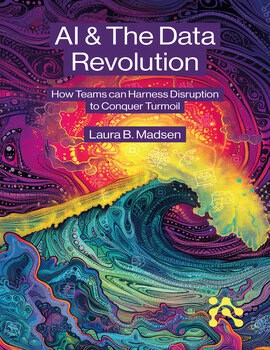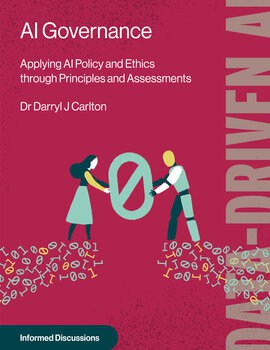Enterprise Intelligence
Enterprise Intelligence: Bridging the Gaps between Wisdom, Business Intelligence, Knowledge Graphs, and Artificial Intelligence, by Eugene Asahara
Harness the Power of BI and AI—Utilize highly curated BI data, an enterprise knowledge graph, and advanced AI to build a resilient and intelligent enterprise capable of making innovative decisions.
Topics
Prologue
The Intelligence of Humanity
LLMs are ML Models
Business Intelligence
You Got AI in My BI! You Got BI in My AI!
Putting the ‘I’ Back into BI
Chapter 1: Introduction
The Puppeteers of an Enterprise
Fragmented Knowledge
Can a Single Entity Know Most Things About Most Things?
Beyond Traditional BI Analysts and Managers
What Do Human BI Analysts See?
The Big Gap Between Human and Machine Intelligence
AI Gone Viral
My Research Assistant, ChatGPT
My Feeling About AI
David and Goliath
We Think Because We Are
The Book’s TL;DR
Could a Private LLM have Written this Book?
ChatGPT’s Visual Representation for this Book
The Book Structure
Topics Punted to Future Books in the Series
Query Languages other than SQL
Non-Time Series Conditional Probabilities
Bayesian Probabilities
Functions
Linear and Non-linear Regression
The Many Ways to Talk to an LLM
Digital Twins
Frightening Things: Code and Math
Striving for Vendor Neutrality
Chapter 2: BI in the Era of ML, DS, and AI
Even an R&D-Focused Enterprise is still an Enterprise
My BI Misunderstanding
Encoding Knowledge
It’s Like Books but Looks Like Tinker Toys
Expert Systems and the Semantic Web
[Diverse Human Expertise] + ((KG + LLM) + BI) = AEI
Intuition for this Book
Version 1—SQL Server Performance Tuning Web (ca. 2004)
Version 2—Map Rock (ca. 2011)
Version 3—Augmented Enterprise Intelligence (Present)
KG Development with LLM Assistance
The Puppet Looks More Lifelike
Chapter 3: The Intelligence of a Business
A Business is as an Organism
The Brain: A Centralized Repository of Knowledge
EKG versus Conventional Databases
Humans as Components of the Business Organism
Survival of the Smartest?
Business Intelligence, Performance Management, Process Management
Too-puhls (Tuples) and Dataframes
Embracing Complexity
Novel Solutions to Novel Problems
Tell Me Something of Value that I Don’t Already Know
We Don’t Know What We Don’t Know
Tribal Knowledge: Most Understanding is Trapped in the Heads of Individuals
But Things Somehow Work
Sampling of the Incalculably Large Knowledge Space of an Enterprise
A Rockhound Analogy
Widening Breadth of Data
LLMs Opened Floodgates for Inclusion of Unstructured Data
The Unstructured Data Majority Unlocked with AI
AI Quality and Acceptance Hit a Critical Mass
Very Book Smart, Although a bit Lacking in Common Sense … For Now
The Ubiquitous Time Dimension
Conclusion to The Intelligence of a Business
Chapter 4: Knowledge Graphs
Symbiotic Relationship between KGs and LLMs
The Elusive Knowledge Graph
The KG and LLM Symbiotic Relationship
Mitigating Friction Between Human and Machine Intelligence
Knowledge Graph Foundations
The Effort to Create KGs
Nature of Representation
Probabilistic versus Assertive Knowledge
Interactivity and Dynamic Responses
Complementing Each Other
LLMs Queries can be slow compared to more traditional database queries
Trustworthiness and Verification
Regulation
Cost
The Sweet Spot of LLM Ability for KGs
LLMs are Very Far from Six Sigma!
Ontologies and Taxonomies
Relational Models are Ontologies
Ontology Example
Knowledge Graph Artifact Sources
Feasibility of Developing and Maintaining KGs
Semantic Web and KGs
Semantic Web, RDF, SPARQL, and OWL
Semantic Layer versus Knowledge Graph
Enterprise Knowledge Graph (EKG) versus Knowledge Graph
Node Identifiers
KG Users Ontology
Conclusion to Knowledge Graphs
Chapter 5: Data Catalog
The Ontology of the Databases
Data Catalog Foundations
Semantic Layer and Data Fabric
RDF-encoded Data Catalog
Retrieving Metadata
URI for Tables and Columns
OLAP Cubes in the Enterprise-Scoped Data Catalog
Source to Target Mapping
Database Views as Abstractions
“Lowly-Curated” Data
Data from Partners, Vendors, Customers
The Value of Questionable Data
Ad-hoc Data
Non-BI Data Left on the Cutting Room Floor
Chapter 6: Business Intelligence
Benefits of Traditional BI
Highly Curated
Highly Performant
But My BI Seems Fast Enough
Federated Databases
Kyvos Insights Cloud-based OLAP
User-Friendly
BI Users
Traditional BI Users
Knowledge Workers – Massive Expansion of BI Consumers
AI Agent
Append-Only Data Strategy in Business Intelligence
Visualization Tools
Chapter 7: Data Mesh
Expanding the Reach for BI
The Centralized BI Team Bottleneck
Decentralization of BI Effort
Data Governance Team
Data Products
Data Product Service Level Agreements (SLA)
Data Products Per Domain
But Wait, Aren’t LLMs Monolithic Models?
Data Mesh, Data Fabric, Data Catalog, and Semantic Layer
Optimized Cubes as the Consumer-Facing Semantic Layer
The KG Use for Data Mesh
Knowledge Bog
KG “Data Products”
OLAP Cubes as Data Products with Coherent Bounded Contexts
Distributed Construction of the KG in the Data Mesh Paradigm
Data Products for Mappings
Master Data Management
RDF Mapping
Automated Similarity Mapping with LLMs
Database-Derived Ontologies
KG Update Tracking
KG Update Exceptions
Art Gallery Ontology Creation Example Using Protégé and GitHub
Chapter 8: Architecture of the AEI
Architecture Overview
Development Tools
GitHub
Visual Code
Ontology Composition Tools
Databases
Data Warehouses, Data Marts
Graph Databases
Relationships Only—But Know Where to Find the Information
Graph Database Options
Neo4j
Optimized cubes
IT Manager’s Nightmare
Optimized Cubes Make a Comeback
SQL Server Analysis Services and Kyvos
Pre-Aggregation for Consistently High Query Performance
The Unique Cache of Pre-Aggregations
Navigating the Vast Cubespace
Big Data Systems and the Expanding User Base
Kyvos: Beyond Aggregation to Aggregation Management
The Balanced Approach of the Dimensional Model
The Critical Nature of BI Data
End-User Perspectives: The Persistence of Cubes
Enhancing Analytical Speed with Optimized OLAP
High Query Concurrency
The Two Extremes of Cubes and Graphs
Large Language Model
Private Vector Database
Relational Database
Cloud File Storage
Chapter 9: BI-Charged EKG Components
Why Go Through the Trouble of Storing BI Insights?
Guided Exploration with the ISG and TCW
Navigating with Intuition versus Guided Systems
The Value of Collective Exploration
Finding Indirect Pathways versus Direct Correlation
Big Brother?
Events
Sources with a Plethora of Events
Derived Events
The Event Ensemble
Generalized Schema for Events
Event Ensemble in a Mosaic of Cubes
Event Ensemble Integration
Avoid Copying Massive Numbers of Facts
Event Storming as a KG Kickoff
Event Storming as a Periodic Sanity Check
A Simple Event Storming Example
Ask ChatGPT to Organize the Event Storming Session
Rare Events and Risk Management
The Insight Space Graph
The QueryDef Object
A KG of Dataframes
Dataframe Individuals
Spaces
Physical Space
Data Space
Cube Space (Semantic Layer)
Insight Space—the Final Frontier
Business Intelligence Insights
Line Graphs
Bar Charts
Pie Charts
Stacked Bar Chart
Scatter Plots
ML Model Visualizations
Models
ML Models Built from a Dataframe
Business Rules
ML Models are Business Rules
BI Analyst AI Use Cases
Contextual Information Delivery
Guided Exploration
Enhanced Data Analysis
The Tuple Correlation Web
Time
Time Events
The “Social Network” of Tuples
Putting Old Myths and Legends to the Test
Correlation Algorithms
Bayesian Probabilities
Conditional Probabilities
Pearson Correlation
Spearman Correlation
Pearson Correlation Example
Transforming to Stationary Values
Plotting the Rolling Average Correlation
Correlation Parameters
Determining Lag for Cause and Effect
Time Series Intervals
Casting a Wide Net
Intelligent Query Patterns
Actionable Insights
Detective Query Pattern
The Coach Query Pattern
The MacGyver Query Pattern
Stressing the Correlations and Probabilities
Confounding Correlations
Obvious Correlations
Ask the Experts (the KG)
Why not just ask ChatGPT?
Coefficient of Variation and Slope
EKG Analysis
Object Schema
Objects Dimension Table
ObjectLog Fact Table
Object Archive
Users Schema
User Validation Table
Chapter 10: Special Structures
KPI Strategy Map
Compact Smarts
The Theory of our Corporate Strategies
Gaming KPIs
KPI Correlation Score
Bayesian Belief Networks and Causal Diagrams
Business Process Knowledge
Simple AI-Assisted Strategy Map Example
Refining the Workflow
Limitations of Encoding Knowledge
Trophic Cascades in the TCW
Time Series ISG Models
Time Series Inflection Points
Frequency Domain Analysis
Minimum Data Points
Spectral Components
Component Similarity
Chapter 11: Implementation
Environment
Set Up the KG and DC Environment
Create a Sample Ontology
Load the Data Catalog
Retrieve Data Catalog from SQL Server
Upload Data Catalog into the EKG
Processing BI Queries into the ISG
Query Parsing and Saving
Reusable Components
Filter Components
Set Components
Tuples Components
Query Functions
Uploading to the ISG
Tuple Correlation Example
Web of Pearson Correlations and Conditional Probabilities
Conditional Probabilities
Tuple-Level as Opposed to Conditional Probability Table for Conditional Probabilities
Conditional Probabilities versus Pearson Correlations
Conditional Probability Example
Casting a Wide Net―Pearson Example
Casting a Wide Net with Conditional Probabilities
Retrieval Augmented Generation
RAG Intuition
Self-Reflective RAG
Vector Database
Leveraging Neo4j GDS for Embedding Management and Similarity Analysis
Offloading Vector Tasks to a Vector Database
Prompt Enrichment
Query the TCW like a Social Network
Query the ISG like any Other Ontology
Graph Query Intent Templates
LLM API
Maintenance
Updating the KG
Updating of the TCW and ISG
Batch Updates for KG Data Products
Pruning the ISG and TCW
Re-query with Fast Optimized OLAP
QueryDef Count Settles Down on its Own
BI Consumers with Widely Diverse Focuses
Compelling Statistics Model
Time to Live
AI Pruning
Minimal Relationship Options
Turning off Features
QueryDef Identifiers
Conditional Probability Table
Offloading to a Relational Database
Off-Loading to a LLM
Security
Securing BI OLAP Cubes
Securing the Graph Database
Securing the Data Catalog
Securing the ISG/TCW
Securing the Vector Database
Securing Ourselves from the LLM
Chapter 12: Future Steps
Fine-Tuning LLMs with BI Data
Inference
Inference on the Semantic Web
Subgraphs and Paths
Metrics at Scale
Where Does Data Science and Machine Learning Fit In?
Investment and Sacrifice
No Pain, No Gain
Levels of Pain
Running the Process
Conclusion to Investment and Sacrifice
Conclusion
Appendix: Ontologies and Taxonomies in OOP Terms
Glossary
References
In the unprecedently evolving landscape of technology and business, the terms Business Intelligence (BI) and Artificial Intelligence (AI) represent different facets of “intelligence.” However, when combined, they create a powerful synergy that transforms enterprises into dynamic, highly adaptive entities capable of thriving in an ever-changing ecosystem.
This book is the first in a series designed to guide corporations from lumbering entities to becoming agile, high-performing organisms. By integrating BI structures into an Enterprise Knowledge Graph (EKG), businesses can develop a central nervous system more on par with those of living organisms, to enhance decision-making and performance.
The main topics covered include:
- The Sudden Leap Forward: Understand the problem we face with the sudden advent of high-quality large language models (LLMs) and how they bridge the gap between human and machine intelligence.
- The Intelligence of a Business: Explore the desires, fears, and competitive strategies of enterprises, and the need for an expansive field of vision and a central nervous system akin to living organisms.
- Knowledge Graphs and LLMs: Delve into the components of the EKG, including a Knowledge Graph (KG) authored by subject matter experts, a Data Catalog (DC) that organizes metadata, and BI-derived structures like the Insight Space Graph (ISG) and Tuple Correlation Web (TCW).
- Building the Corporate Brain: Learn how to capture the insights and patterns from BI analysts’ activities across the enterprise, creating a single integrated source of insights that functions like a human brain.
- Architecture and Implementation: Gain practical guidance on the architecture of the EKG, BI-charged components, and special patterns for implementation to solve complex business problems.
With the advent of highly capable and accessible AI, the pieces needed to build an integrated enterprise “brain” are now within reach. This book provides the essential knowledge and tools to harness BI and AI, transforming your business into a thriving, intelligent organism ready to navigate the complexities of the modern world.
Sources of Interest for “Enterprise Intelligence” – Soft Coded Logic (eugeneasahara.com)
About eugene
Eugene Asahara is a Business Intelligence (BI) Architect with a rich history of about 45 years in software development, including 25 years focused on BI, particularly SQL Server Analysis Services (SSAS). He currently works as a Principal Solutions Architect at Kyvos Insights. His exploration of knowledge graphs began in 2005 when he developed Soft-Coded Logic (SCL), a .NET Prolog interpreter designed to modernize Prolog for a data-distributed and semantic world. Later in 2012, Eugene ventured into creating Map Rock, a project aimed at constructing knowledge graphs passively built from BI activity across numerous SSAS cubes. While these initiatives didn’t gain extensive adoption at the time, the lessons learned have proven invaluable. With the emergence of Large Language Models (LLMs), building and maintaining knowledge graphs has become practically achievable. Eugene is leveraging the lessons learned and insights from SCL and Map Rock to this end.
Faculty may request complimentary digital desk copies
Please complete all fields.




